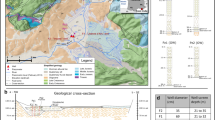Abstract
Flowing well test is one of the tools employed to identify transmissivity and storage coefficient of a confined aquifer where the potentiometric surface is located above the ground surface, so that the groundwater flows naturally from the well without pumping. During a flowing well test, constant hydraulic head is preserved at the well while the discharge from the well decreases with time and the temporal variation of discharge provides significant information about aquifer characteristics. In this study, a simple and straightforward approach is presented as an alternative to a number of graphical or error minimization-based techniques available in the literature for analyzing data from flowing well tests. The proposed method employs a polynomial regression equation to establish a link between observed discharge and the theoretical dimensionless discharge that is introduced in the analytical solution, so as to retrieve the aquifer parameters. The method is tested with a vast number of synthetically generated data sets as well as a real data set reported in the literature. Besides its simplicity, the present method is seen to produce highly accurate and reliable estimations.






Similar content being viewed by others
References
Batu V (1998) Aquifer hydraulics: a comprehensive guide to hydrogeologic data analysis. Wiley: New York
Bouwer H, Rice RC (1976) A slug test method for determining hydraulic conductivity of unconfined aquifers with completely or partially penetrating wells. Water Resour Res 12:423–428
Cassiani G, Kabala Z, Medina M (1999) Flowing partially penetrating well: solution to a mixed-type boundary value problem. Adv Water Resour 23:59–68
Chen YJ, Yeh HD (2009) Parameter estimation/sensitivity analysis for an aquifer test with skin effect. Ground Water 47:287–299
Cooper HH, Jacob CE (1946) A generalized graphical method for evaluating formation constants and summarizing well field history. Am Geophys Union Trans 27:526–534
Cooper HH, Bredehoeft JD, Papadopulos IS (1967) Response of a finite diameter well to an instantaneous charge of water. Water Resour Res 3:263–269
Gibbons JD, Chakraborti S (2010) Nonparametric statistical inference, Fifth Edition. Chapman and Hall/CRC, 650 p
Glover RE (1978) Transient ground water hydraulics. Water Resources Publications, Fort Collins, Colorado, 413 p
Hantush MS (1964) Hydraulics of wells. In: Chow VT (ed) Advances in hydrosciences, vol. 1. Academic, New York, London, pp 281–432
Jacob CE (1940) The flow of water in an elastic artesian aquifer. Am Geophys Union Trans 21:574–586
Jacob CE, Lohman SW (1952) Nonsteady flow to a well of constant drawdown in an extensive aquifer. Am Geophys Union Trans 334:559–569
Kawecki MW (1993) Recovery analysis from pumping tests with stepped discharge. Ground Water 31:585–592
Kruseman GP, de Ridder NA (1990) Analysis and evaluation of pumping test data. International Institute for Land Reclamation and Improvement, 2nd ed. Wageningen, 377 p
Lin YC, Yang SY, Fen CS, Yeh HD (2016) A general analytical model for pumping tests in radial finite two-zone confined aquifers with Robin-type outer boundary. J Hydrol 540:1162–1175
Lohman SW (1965) Geology and artesian water supply of the Grand Junction area, Colorado. Geol Surv Prof Pap 451:149
Lohman SW (1972) Ground-water hydraulics. In: Professional paper, vol 708. U.S. Geological Survey, Washington, D.C., pp 23–27
Markle JM, Rowe RK, Novakowski KS (1995) A model for the constant-head pumping test conducted in vertically fractured media. Int J Numer Anal Met 19:457–473
Mishra S, Guyonnet D (1992) Analysis of observation-well response during constant-head testing. Ground Water 30:523–528
Ojha CSP (2004) Aquifer parameters estimation using artesian well test data. J Hydrol Eng 91:64–67
Papadopulos IS, Cooper HH (1967) Drawdown in a well of large diameter. Water Resour Res 3:241–244
Perrochet P (2005) A simple solution to tunnel or well discharge under constant drawdown. Hydrogeol J 135:886–888
Renard P (2005) Approximate discharge for constant head test with recharging boundary. Ground Water 43:439–442
Sen Z (1986) Determination of aquifer parameters by the slope matching method. Ground Water 24:217–223
Şahin AU (2016) A new inverse solution assessment for the recovery test using radial basis function collocation method. Water Resour Manag 30:947–962
Şahin AU (2017) Simple methods for quick determination of aquifer parameters using slug tests. Hydrol Res 48:326–339
Şahin AU, Çiftçi E (2016a) An area matching process to estimate the hydraulic parameters using transient constant-head test data. Hydrol Res 47:919–931
Şahin AU, Çiftçi E (2016b) An integration based estimation approach for the determination of slug test parameters under various flow geometries. Arab J Geosci 9:636
Singh S (2007) Simple approximation of well function for constant drawdown variable discharge artesian wells. J Irrig Drain Eng 1333:282–285
Singh S (2009) Kernel method for transient rate and volume of well discharge under constant drawdown. J Irrig Drain Eng 135:252–256
Smith PL (1937) Heat flow in an infinite solid bounded internally by a cylinder. J Appl Phys 8:441–448
Swamee PK, Mishra GC, Chahar BR (2000) Simple approximation for flowing well problem. J Irrig Drain Eng 1261:65–67
Theis CV (1935) The relationship between the lowering of the piezometric surface and the rate and duration of discharge of a well using ground-water storage. Trans Am Geophys Union 16:519–524
Wang CT, Yeh HD (2008) Obtaining the steady-state drawdown solutions of constant-head and constant-flux tests. Hydrol Process 22:3456–3461
Wendland E, Gomes LH, Rodrigo MP (2014) Use of convolution and geotechnical rock properties to analyze free flowing discharge test. An Acad Bras Cienc 86:117–126
Yeh HD, Chang YC (2013) Recent advances in modeling of well hydraulics. Adv Water Resour 51:27–51
Author information
Authors and Affiliations
Corresponding author
Rights and permissions
About this article
Cite this article
Ciftci, E. A practical approach for the interpretation of flowing well tests. Arab J Geosci 11, 761 (2018). https://doi.org/10.1007/s12517-018-4137-7
Received:
Accepted:
Published:
DOI: https://doi.org/10.1007/s12517-018-4137-7




